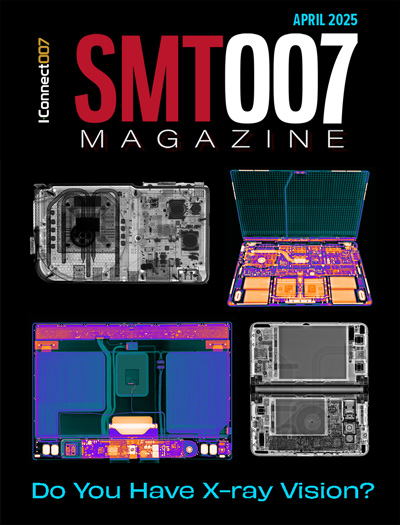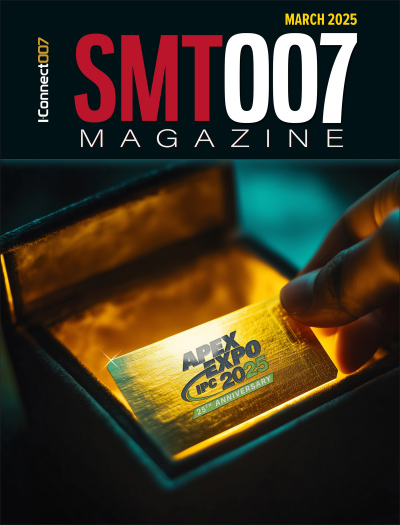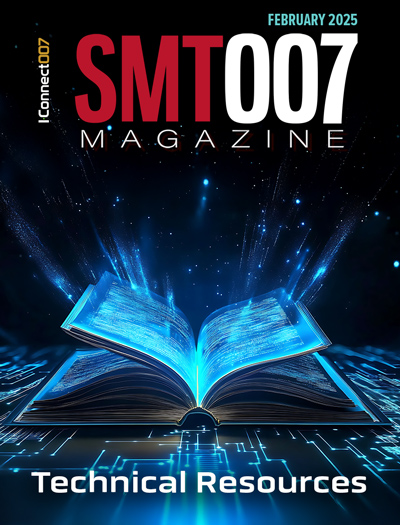-

- News
- Books
Featured Books
- smt007 Magazine
Latest Issues
Current Issue
Do You Have X-ray Vision?
Has X-ray’s time finally come in electronics manufacturing? Join us in this issue of SMT007 Magazine, where we answer this question and others to bring more efficiency to your bottom line.

IPC APEX EXPO 2025: A Preview
It’s that time again. If you’re going to Anaheim for IPC APEX EXPO 2025, we’ll see you there. In the meantime, consider this issue of SMT007 Magazine to be your golden ticket to planning the show.

Technical Resources
Key industry organizations–all with knowledge sharing as a part of their mission–share their technical repositories in this issue of SMT007 Magazine. Where can you find information critical to your work? Odds are, right here.
- Articles
- Columns
Search Console
- Links
- Media kit
||| MENU - smt007 Magazine
EIPC Technical Snapshot: Cleanliness
March 1, 2021 | Pete Starkey, I-Connect007Estimated reading time: 5 minutes
John Ling’s invitation to the fifth in EIPC’s series of Technical Snapshots was as droll as we have come to expect: “In these confined days of lockdown, and exhortations to stay at home and only go out for exercise, this only exercises the natural inclination to hop on a ‘plane to some sunshine.’ Although not the same as Factor 20, one of our webinars gives a high degree of protection from harmful ignorance, and you do not have to go out in the cold.”
Cleanliness was the focus of this informative and enlightening event on Feb. 17, 2021, introduced by EIPC technical director Tarja Rapala-Virtanen and moderated by EIPC board member Christian Behrendt, CEO of German PCB fabricator ILFA.
Freddy Gilbert
His first speaker was Freddy Gilbert, technology analyst with Zestron Europe, with a presentation that described in detail the technique of ion chromatography and its benefits in assessing the cleanliness of PCB assemblies by determining the nature and extent of ionic contamination.
Gilbert explained that specific ions could trigger corrosion on specific areas of electronic assemblies and that because of differences in their hygroscopic properties, the moisture-related failure mechanisms that each could induce would be related to the ambient relative humidity. Ion chromatography could identify the presence and concentrations of anions and cations as well as weak organic acid residues from fluxes and solder pastes. It could also reveal quality problems with PCB materials, for example, under-cured solder mask. The test procedure was defined in the IPC Test Methods Manual: IPC TM 650 2.3.28A.
How did it work? Gilbert described the five stages:
- Sample extraction with a suitable solvent mixture.
- Injection of the sample into the separating column.
- Separation as different species moved at different speeds through the column.
- Detection by conductivity measurement.
- Analysis of the results in terms of identification of ionic species and calculation of their concentration.
IPC-CH-65B gave guidelines for acceptable limits. Interpretation of the analysis results helped in identifying the source of the contamination.
He made it very clear that ion chromatography was entirely different from ROSE testing. Ion chromatography was a complex analytical technique, most useful for validation procedures and risk analysis. ROSE testing gave a global value for contamination, expressed in terms of sodium chloride equivalent, and was more suitable for process control. An ion chromatography test could take 20 hours, whereas a ROSE test could be completed in one hour. Each procedure had its particular area of applicability and the results were not directly comparable.
Gilbert discussed the effects of varying extraction parameters on response characteristics: Standard values according to IPC TM 650 TM 2.3.28 were one hour at 80°C with 75/25 v/v isopropanol/water. He demonstrated that extraction time and isopropanol content had little influence on the extraction of most anions and cations; higher temperatures increased measured ion concentrations and the measured concentrations of weak organic acids tended to increase with increasing extraction time and isopropanol content.
Professor Rajan Ambat
The second presentation was given by Professor Rajan Ambat from the Centre for Electronic Corrosion at the Technical University of Denmark, who discussed the significance of the cleanliness of electronic assemblies in improving their intrinsic humidity robustness and corrosion reliability.
He remarked that cleanliness-related effects could result from PCB fabrication, assembly, handling or end-use, although the assembly process was the predominant source. The chemistry of residues was significant because the responses of different ionic residues to humidity depended on critical humidity levels and other factors. Regarding flux residues, the overall chemistry depended on the soldering method, and the activator component was particularly critical. It was important to optimise the amount of flux used and to avoid excessive application. The residue from reflow processes was different from other residues, and components such as rosin, resin, and binder were also important.
Two effects were considered critical: the opening-up of the residue, enabling activator components to be released; and the spreading of residue, enabling adjacent points on the assembly to be potentially connected under humidity. The stand-off height of a component was an important factor in determining the amount of residue and how it interacted with humidity. The cleanliness of the assembly was also an important factor affecting the performance of conformal coating, whose adhesion could be adversely affected by the chemistry of the residue.
Professor Ambat concluded his presentation by announcing a virtual seminar on climatic reliability of electronics: global challenges and perspectives, March 4-5, 2021.
Emma Hudson
The presentations of Freddy Gilbert and Professor Ambat provided an appropriate background for EIPC vice-president Emma Hudson to review the proposed changes to the cleanliness section of the IPC-6012DA-WAM1 Automotive Applications Addendum, which would provide a more comprehensive approach to determining acceptable contamination levels on bare PCBs.
IPC-6012DA: Automotive Applications Addendum to IPC-6012D had originally been issued in 2016 to cater for PCBs specifically used in the automotive industry, and Amendment 1, which was issued in 2018, had included revisions to the cleanliness requirements, where the task group believed there was a need to differ for automotive applications. The existing required techniques were considered inadequate and there was a need to expand the required testing to ensure that PCBs being supplied would continue to meet the needs of the automotive assembler. The Technical Cleanliness proposal would allow a move toward a risk-based approach on the level of foreign-object-debris present rather than a zero-tolerance approach.
Test methods recommended for process and material qualification and for quarterly verification were listed as ion chromatography (IC), surface insulation resistance (SIR) and resistance of solvent extract (ROSE). Hudson made clear the differences between “recommended,” “should,” and “shall” in the wording of IPC specifications as she reviewed the current cleanliness section in which there were very few “requirements” and lots of “recommendations.” The decision had been made to review the whole cleanliness section, as well as adding Technical Cleanliness, and she listed the proposed changes. Significantly, it was proposed that major PCB qualification “shall” include IC, SIR, and ROSE testing, and that ROSE or other available test methods would be allowed for daily process control, as agreed between user and supplier. The requirement for lot qualification would be the same as for daily process control. An added requirement was for the manufacturer to monitor measured contamination by statistical process control, and OSP-finished boards would no longer be exempt from testing. Test results and frequency were still required to be as agreed between user and supplier.
The justification for these proposals was that the current addendum had only the ROSE test as a requirement, whereas the other tests were “recommended” or “should” be conducted. ROSE did not tell whether contamination levels would lead to failures, or identify what specific contaminants were on the PCB. Therefore a more comprehensive approach was needed in determining and monitoring acceptable contamination levels.
Christian Behrendt led a very constructive interactive discussion session with the presenters, which brought an impressive technical webinar to a close.
Grateful thanks to the presenters for generously sharing their knowledge, and to EIPC for organising another in their excellent series of Technical Snapshot events.
Suggested Items
KYZEN Focuses on Aqueous Cleaning and Stencil Cleaning at SMTA Wisconsin
04/24/2025 | KYZEN'KYZEN, the global leader in innovative environmentally responsible cleaning chemistries, will exhibit at the SMTA Wisconsin Expo and Tech Forum, scheduled to take place Tuesday, May 6 at the Crowne Plaza Milwaukee Airport. KYZEN will be on-site to provide attendees with information about aqueous cleaning chemistry AQUANOX A4618 and stencil cleaner KYZEN E5631J.
SMTA Bridging the Skills Gap in Arizona
04/24/2025 | Marcy LaRont, I-Connect007One area where SMTA really excels is through its local chapters. On April 16, 2025, I-Connect007's Marcy LaRont attended the Workforce Breakfast during the SMTA Arizona Expo & Tech Forum in Mesa, which featured more than 50 electronics professionals from the local area, including defense OEMs, and others who were attending for the first time. Blackfox and Hyrel Technologies sponsored the event. The keynote presentation featured Sean Denny, a professor at Estrella Mountain Community College, who emphasized a clear need for skilled hand soldering technicians.
IPC Releases Version 2.0 of IPC-2591, Connected Factory Exchange, with Expanded Device Coverage and Smarter Data
04/23/2025 | IPCIPC announces the release of IPC-2591, Connected Factory Exchange (CFX), Version 2.0, the global standard for plug-and-play, machine-to-machine, and machine-to-system communication for digital manufacturing.
ViTrox Marks 25 Years of Innovation with Cutting-Edge Solutions at NEPCON China 2025 in Shanghai
04/18/2025 | ViTrox TechnologiesViTrox, which aims to be the World’s Most Trusted Technology Company, is proud to announce its participation in NEPCON China 2025, taking place from April 22–24, 2025, at Booth #1E45, Shanghai World Expo Exhibition & Convention Centre (SWEECC).
Indium Experts to Present on Power Electronics at PCIM Europe 2025
04/17/2025 | Indium CorporationAs one of the leading materials providers to the power electronics assembly and e-Mobility industries, Indium Corporation experts will share their technical insight and knowledge on a variety of industry-related topics throughout PCIM Europe, May 6-8, in Nuremberg, Germany.


